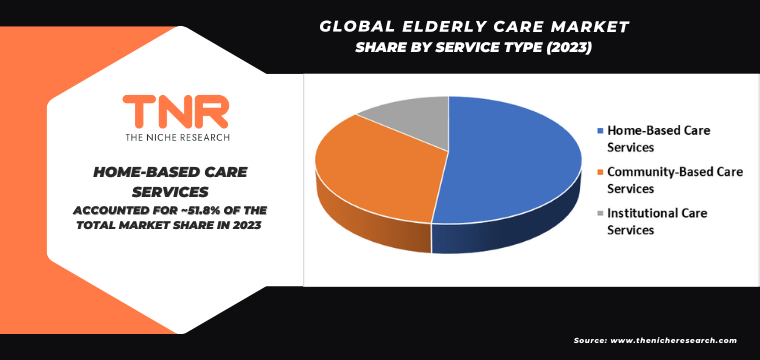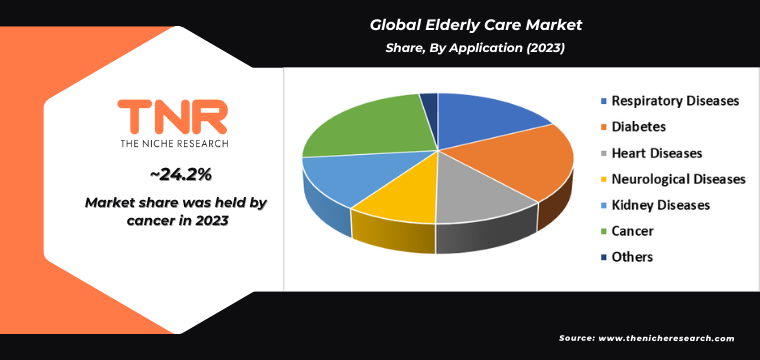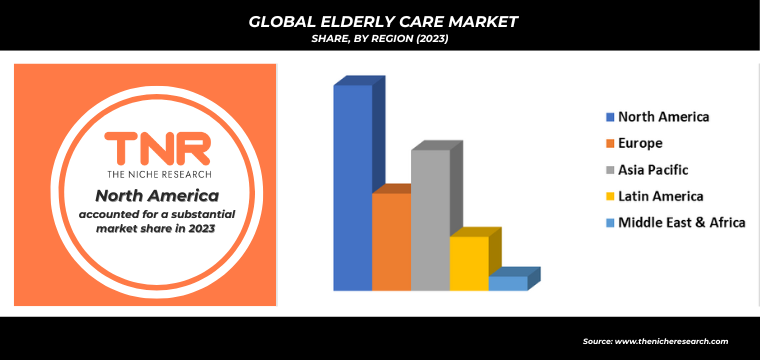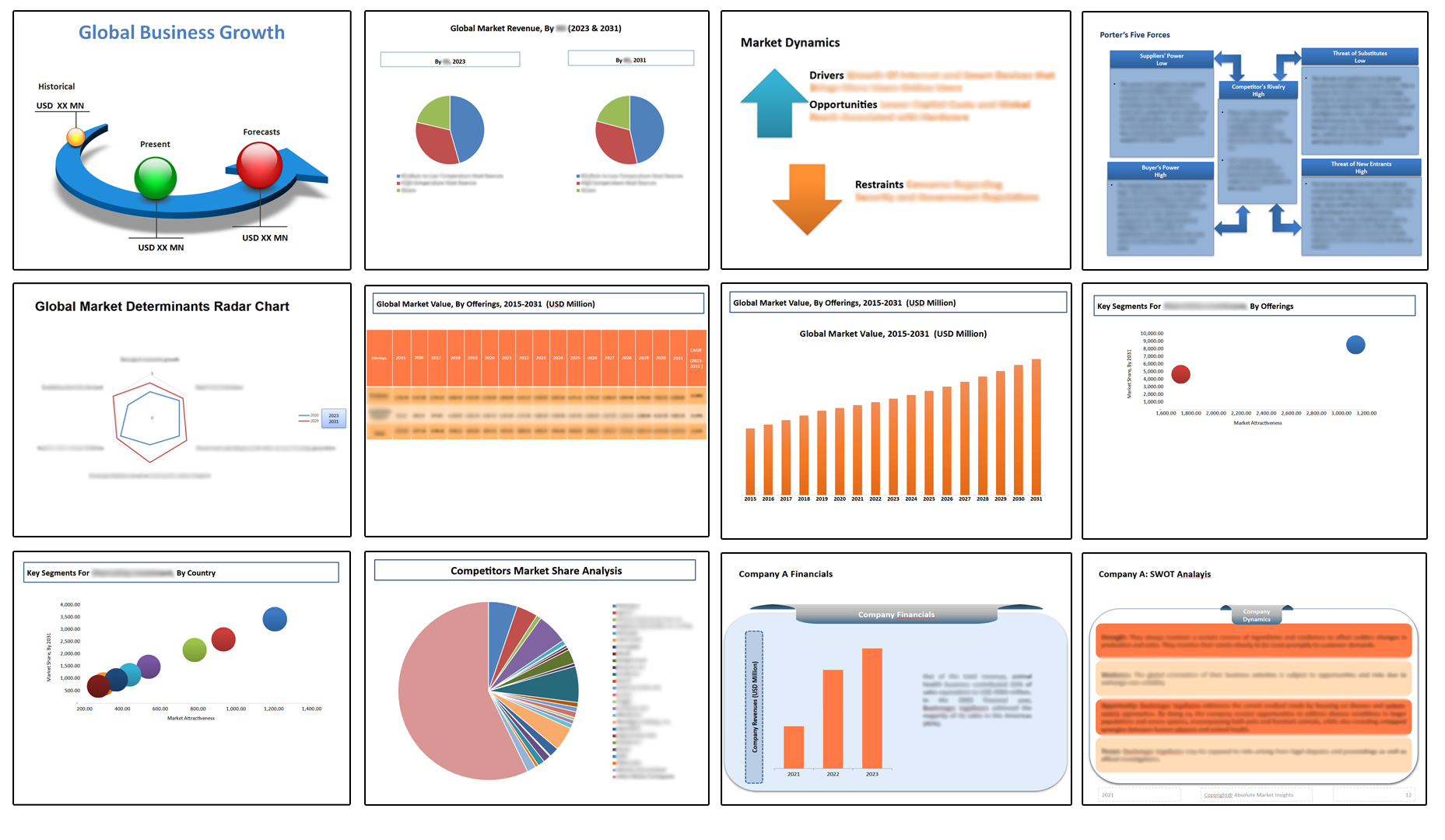Global Elderly Care Market, By Service Type, By Application, By Region & Segmental Insights Trends and Forecast, 2024 – 2034
- Industry: Healthcare
- Report ID: TNR-110-1199
- Number of Pages: 420
- Table/Charts : Yes
- July, 2024
- Base Year : 2024
- No. of Companies : 10+
- No. of Countries : 29
- Views : 10235
- Covid Impact Covered: Yes
- War Impact Covered: Yes
- Formats : PDF, Excel, PPT
The elderly care market is a burgeoning sector within the healthcare industry, driven by the increasing global aging population. This market encompasses a wide array of services, including in-home care, assisted living facilities, nursing homes, and adult day care services. The primary growth driver in this sector is the rising life expectancy, which necessitates prolonged and specialized care for the elderly. Additionally, advancements in medical technology and the increasing prevalence of chronic diseases among the elderly are bolstering the demand for comprehensive care solutions.
Current trends in the elderly care market highlight a significant shift towards personalized and patient-centered care. There is an increasing adoption of digital health technologies, such as telehealth and remote monitoring, which enhance the quality of care while reducing costs. The integration of artificial intelligence and machine learning in care management is also gaining traction, enabling predictive analytics for better health outcomes.
Opportunities in the market are vast, particularly in the development of innovative care models and the expansion of home-based care services. Investment in smart home technologies and robotics tailored for elderly care presents a promising avenue for growth. Additionally, the rising awareness and demand for mental health services among the elderly open up new prospects for specialized care providers. Overall, the elderly care market is poised for substantial growth, driven by demographic shifts and technological advancements. In Terms of Revenue, the Global Elderly Care Market was Worth US$ 1,145.7 Bn in 2023, Anticipated to Witness CAGR of 7.8% During 2024 – 2034.

Trends in the Global Elderly Care Market
- Adoption of Digital Health Technologies: Telehealth, remote monitoring, and wearable devices are transforming how care is delivered to the elderly. Telehealth platforms enable real-time consultations with healthcare professionals, reducing the need for physical visits and providing timely medical assistance. Remote monitoring systems, including wearable health trackers, help in continuous health monitoring, alerting caregivers and medical personnel to any abnormalities. For instance, in January 2023, Baracoda, a company specializing in innovative IoT solutions, introduced BHeart, a health tracker boasting an unlimited battery life. This technology-driven approach not only enhances the quality of care but also offers cost-effective solutions by minimizing hospital admissions and enabling proactive health management. The integration of these technologies is crucial for meeting the growing demand for efficient and accessible elderly care services.
- Personalized and Patient-Centered Care: This approach focuses on tailoring care plans to meet the individual needs and preferences of elderly patients, ensuring a more holistic and satisfactory care experience. By leveraging data analytics and health informatics, care providers can develop customized treatment plans that address the unique medical, emotional, and social needs of each patient. This trend is also reflected in the rise of concierge healthcare services and personalized home care solutions, which offer a higher level of personalization and attention. Emphasizing individualized care not only improves patient outcomes but also enhances the overall quality of life for the elderly, fostering a more compassionate and effective care environment.
Home-based care services have emerged as a dominant segment in the global elderly care market due to their ability to provide personalized and comfortable care within the familiar surroundings of the patient’s home.
This segment has gained traction as it offers a cost-effective alternative to traditional nursing homes and assisted living facilities, reducing the burden on healthcare systems. Additionally, home-based care enhances the quality of life for elderly individuals by allowing them to maintain their independence and stay connected with family. Technological advancements, such as remote monitoring and telehealth, have further bolstered the appeal of home-based care, enabling continuous health tracking and timely medical intervention. As a result, the demand for home-based care services is rapidly increasing, driving growth in the elderly care market.

In 2023, the diabetes segment solidified its position as the second-largest category within the global elderly care market.
This growth is attributed to the rising prevalence of diabetes among the elderly population, necessitating specialized care and management. The segment’s expansion is driven by the increasing demand for comprehensive diabetes care services, including monitoring, medication management, and lifestyle counselling. Advances in technology, such as continuous glucose monitoring systems and telehealth services, have significantly improved diabetes management, making it easier for elderly patients to maintain stable blood sugar levels. Additionally, the integration of personalized care plans tailored to individual needs has enhanced treatment outcomes, further solidifying the diabetes segment’s prominence in the elderly care market. This trend underscores the critical need for targeted healthcare solutions for chronic conditions among the aging population.

In 2023, North America solidified its dominance in the global elderly care market, contributing a revenue share of 40.2%.
This dominance is driven by several factors, including a well-established healthcare infrastructure, high healthcare expenditure, and a growing elderly population. The region’s advanced medical technology and widespread adoption of innovative care solutions, such as telehealth and remote patient monitoring, have significantly enhanced the quality and accessibility of elderly care services. Additionally, favourable government policies and substantial investment in healthcare services and facilities have further bolstered market growth
. The increasing prevalence of chronic diseases among the elderly, coupled with a strong focus on personalized and home-based care, has also contributed to North America’s prominent position in the elderly care market. For instance, Research by the National Council on Aging (NCOA) indicates that almost 95% of adults aged 60 and older live with at least one chronic condition, and nearly 80% suffer from two or more chronic conditions.

Competitive Landscape
Some of the players operating in the elderly care market are
- Benesse Style Care Co., Ltd
- Brookdale Senior Living Inc.
- Capital Home Care
- Cascade Living
- Econ Healthcare Group
- Epoch Elder Care
- EXTENDICARE
- Genesis HealthCare
- Gentiva
- Health Serve
- Home Instead, Inc.
- Knight Health Holdings, LLC (Kindred Hospitals)
- Lana Life Care
- NMC ProVita International Medical Center, LLC
- RIEI Co., Ltd.
- ST LUKE’S ELDERCARE LTD.
- Sunrise Senior Living
- Other Industry Participants
Global Elderly Care Market Scope
| Report Specifications | Details |
| Market Revenue in 2023 | US$ 1,145.7 Bn |
| Market Size Forecast by 2034 | US$ 2,617.4 Bn |
| Growth Rate (CAGR) | 7.8% |
| Historic Data | 2016 – 2022 |
| Base Year for Estimation | 2023 |
| Forecast Period | 2024 – 2034 |
| Report Inclusions | Market Size & Estimates, Market Dynamics, Competitive Scenario, Trends, Growth Factors, Market Determinants, Key Investment Segmentation, Product/Service/Solutions Benchmarking |
| Segments Covered | By Service Type, By Application, By Region |
| Regions Covered | North America, Europe, Asia Pacific, Middle East & Africa, Latin America |
| Countries Covered | U.S., Canada, Mexico, Rest of North America, France, The UK, Spain, Germany, Italy, Nordic Countries (Denmark, Finland, Iceland, Sweden, Norway), Benelux Union (Belgium, The Netherlands, Luxembourg), Rest of Europe, China, Japan, India, New Zealand, Australia, South Korea, Southeast Asia (Indonesia, Thailand, Malaysia, Singapore, Rest of Southeast Asia), Rest of Asia Pacific, Saudi Arabia, UAE, Egypt, Kuwait, South Africa, Rest of Middle East & Africa, Brazil, Argentina, Rest of Latin America |
| Key Players | Brookdale Senior Living Inc., EXTENDICARE, Gentiva, Knight Health Holdings, LLC (Kindred Hospitals), Sunrise Senior Living, Genesis HealthCare, Home Instead, Inc., ST LUKE’S ELDERCARE LTD., NMC ProVita International Medical Center, LLC, Benesse Style Care Co., Ltd, Econ Healthcare Group, Epoch Elder Care, Lana Life Care, Health Serve, Capital Home Care, Cascade Living, RIEI Co., Ltd. |
| Customization Scope | Customization allows for the inclusion/modification of content pertaining to geographical regions, countries, and specific market segments. |
| Pricing & Procurement Options | Explore purchase options tailored to your specific research requirements |
| Contact Details | Consult With Our Expert
Japan (Toll-Free): +81 663-386-8111 South Korea (Toll-Free): +82-808- 703-126 Saudi Arabia (Toll-Free): +966 800-850-1643 United Kingdom: +44 753-710-5080 United States: +1 302-232-5106 E-mail: askanexpert@thenicheresearch.com
|
Global Elderly Care Market
By Service Type
- Home-Based Care Services
- Personal Care Services
- Companion Care
- Medication Management
- Home Health Nursing
- Physical Therapy
- Occupational Therapy
- Speech Therapy
- Medical Equipment and Supplies
- Community-Based Care Services
- Adult Day Programs
- Social and Recreational Activities
- Meal Services
- Transportation Services
- Home-Delivered Meals
- Institutional Care Services
- Assisted Living Services
- Skilled Nursing Care
- Memory Care
- Hospice and Palliative Care
- Rehabilitation Services
By Application
- Respiratory Diseases
- Diabetes
- Heart Diseases
- Neurological Diseases
- Kidney Diseases
- Cancer
- Others
By Region
- North America (U.S., Canada, Mexico, Rest of North America)
- Europe (France, The UK, Spain, Germany, Italy, Nordic Countries (Denmark, Finland, Iceland, Sweden, Norway), Benelux Union (Belgium, The Netherlands, Luxembourg), Rest of Europe)
- Asia Pacific (China, Japan, India, New Zealand, Australia, South Korea, Southeast Asia (Indonesia, Thailand, Malaysia, Singapore, Rest of Southeast Asia), Rest of Asia Pacific)
- Middle East & Africa (Saudi Arabia, UAE, Egypt, Kuwait, South Africa, Rest of Middle East & Africa)
- Latin America (Brazil, Argentina, Rest of Latin America)
Report Layout:

Table of Contents
Note: This ToC is tentative and can be changed according to the research study conducted during the course of report completion.
**Exclusive for Multi-User and Enterprise User.
Global Elderly Care Market
By Service Type
- Home-Based Care Services
- Personal Care Services
- Companion Care
- Medication Management
- Home Health Nursing
- Physical Therapy
- Occupational Therapy
- Speech Therapy
- Medical Equipment and Supplies
- Community-Based Care Services
- Adult Day Programs
- Social and Recreational Activities
- Meal Services
- Transportation Services
- Home-Delivered Meals
- Institutional Care Services
- Assisted Living Services
- Skilled Nursing Care
- Memory Care
- Hospice and Palliative Care
- Rehabilitation Services
By Application
- Respiratory Diseases
- Diabetes
- Heart Diseases
- Neurological Diseases
- Kidney Diseases
- Cancer
- Others
By Region
- North America (U.S., Canada, Mexico, Rest of North America)
- Europe (France, The UK, Spain, Germany, Italy, Nordic Countries (Denmark, Finland, Iceland, Sweden, Norway), Benelux Union (Belgium, The Netherlands, Luxembourg), Rest of Europe)
- Asia Pacific (China, Japan, India, New Zealand, Australia, South Korea, Southeast Asia (Indonesia, Thailand, Malaysia, Singapore, Rest of Southeast Asia), Rest of Asia Pacific)
- Middle East & Africa (Saudi Arabia, UAE, Egypt, Kuwait, South Africa, Rest of Middle East & Africa)
- Latin America (Brazil, Argentina, Rest of Latin America)
The Niche Research approach encompasses both primary and secondary research methods to provide comprehensive insights. While primary research is the cornerstone of our studies, we also incorporate secondary research sources such as company annual reports, premium industry databases, press releases, industry journals, and white papers.
Within our primary research, we actively engage with various industry stakeholders, conducting paid interviews and surveys. Our meticulous analysis extends to every market participant in major countries, allowing us to thoroughly examine their portfolios, calculate market shares, and segment revenues.
Our data collection primarily focuses on individual countries within our research scope, enabling us to estimate regional market sizes. Typically, we employ a bottom-up approach, meticulously tracking trends in different countries. We analyze growth drivers, constraints, technological innovations, and opportunities for each country, ultimately arriving at regional figures.Our process begins by examining the growth prospects of each country. Building upon these insights, we project growth and trends for the entire region. Finally, we utilize our proprietary model to refine estimations and forecasts.
Our data validation standards are integral to ensuring the reliability and accuracy of our research findings. Here’s a breakdown of our data validation processes and the stakeholders we engage with during our primary research:
- Supply Side Analysis: We initiate a supply side analysis by directly contacting market participants, through telephonic interviews and questionnaires containing both open-ended and close-ended questions. We gather information on their portfolios, segment revenues, developments, and growth strategies.
- Demand Side Analysis: To gain insights into adoption trends and consumer preferences, we reach out to target customers and users (non-vendors). This information forms a vital part of the qualitative analysis section of our reports, covering market dynamics, adoption trends, consumer behavior, spending patterns, and other related aspects.
- Consultant Insights: We tap into the expertise of our partner consultants from around the world to obtain their unique viewpoints and perspectives. Their insights contribute to a well-rounded understanding of the markets under investigation.
- In-House Validation: To ensure data accuracy and reliability, we conduct cross-validation of data points and information through our in-house team of consultants and utilize advanced data modeling tools for thorough verification.
The forecasts we provide are based on a comprehensive assessment of various factors, including:
- Market Trends and Past Performance (Last Five Years): We accurately analyze market trends and performance data from preceding five years to identify historical patterns and understand the market’s evolution.
- Historical Performance and Growth of Market Participants: We assess the historical performance and growth trajectories of key market participants. This analysis provides insights into the competitive landscape and individual company strategies.
- Market Determinants Impact Analysis (Next Eight Years): We conduct a rigorous analysis of the factors that are projected to influence the market over the next eight years. This includes assessing both internal and external determinants that can shape market dynamics.
- Drivers and Challenges for the Forecast Period:Identify the factors expected to drive market growth during the forecast period, as well as the challenges that the industry may face. This analysis aids in deriving an accurate growth rate projection.
- New Acquisitions, Collaborations, or Partnerships: We keep a close watch on any new acquisitions, collaborations, or partnerships within the industry. These developments can have a significant impact on market dynamics and competitiveness.
- Macro and Micro Factors Analysis:A thorough examination of both macro-level factors (e.g., economic trends, regulatory changes) and micro-level factors (e.g., technological advancements, consumer preferences) that may influence the market during the forecast period.
- End-User Sentiment Analysis: To understand the market from the end-user perspective, we conduct sentiment analysis. This involves assessing the sentiment, preferences, and feedback of the end-users, which can provide valuable insights into market trends.
- Perspective of Primary Participants: Insights gathered directly from primary research participants play a crucial role in shaping our forecasts. Their perspectives and experiences provide valuable qualitative data.
- Year-on-Year Growth Trend: We utilize a year-on-year growth trend based on historical market growth and expected future trends. This helps in formulating our growth projections, aligning them with the market’s historical performance.
Research process adopted by TNR involves multiple stages, including data collection, validation, quality checks, and presentation. It’s crucial that the data and information we provide add value to your existing market understanding and expertise. We have also established partnerships with business consulting, research, and survey organizations across regions and globally to collaborate on regional analysis and data validation, ensuring the highest level of accuracy and reliability in our reports.









